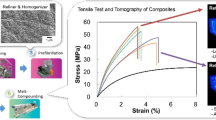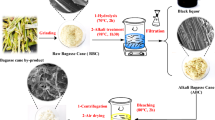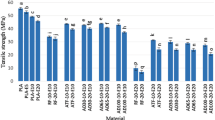Abstract
The aims of this work turn towards the valorization of the underutilized Raw Sugar Beet Pulp by-product to produce white Cellulose Microfibers (CMFs), and its potential effect as a reinforcement for the development of High-Density Polyethylene (HDPE) composites. Pure CMFs were first obtained by subjecting raw SBP to alkali and bleaching treatments. Several characterization techniques were performed to confirm the successful removal of the amorphous compounds from the surface of individual fibers, including SEM, XRD, TGA, and FT-IR analysis. Various CMF loadings (5–10 wt%) were incorporated as bio-fillers into HDPE polymer to evaluate their reinforcing ability in comparison to raw and alkali-treated SBP using twin-screw extrusion followed by injection molding. Styrene–(Ethylene–Butene)–Styrene Three-Block Co-Polymer Grafted with Maleic Anhydride was used as a compatibilizer to improve the interfacial adhesion between fibers and the matrix. Thermal, mechanical, and rheological properties of the produced composite samples were investigated. It was found that the Young’s modulus were gradually increased with increasing of fibers loadings, with a maximum increase of 30% and 26% observed for composite containing 10 wt% of CMFs and raw SBP, respectively, over neat HDPE. While, the use of coupling agent enhances the ductile behavior of the composites. It was also found that all fiber improves the hardness and toughness behavior of all reinforced composites as well as the complex modulus particularly at 10 wt%. The thermal stability slightly increases with the addition of fibers. This study demonstrates a new route for the valorization of SBP by-products. These fibers can be considered as a valuable bio-fillers candidate for the development of composite materials with enhanced properties.












Similar content being viewed by others
Availability of Data and Materials
The datasets used and/or analyzed during the current study are available from the corresponding author on reasonable request.
References
Boussetta, A., Ablouh, E. H., Benhamou, A. A., Taourirte, M., & Moubarik, A. (2021). Valorization of Moroccan brown seaweeds: Elaboration of formaldehyde-free particleboards based on sodium alginate–corn-starch - Mimosa tannin wood adhesives. International Journal of Adhesion and Adhesives, 108, 102894. https://doi.org/10.1016/j.ijadhadh.2021.102894
Awasthi, M. K., Sarsaiya, S., Patel, A., Juneja, A., Singh, R. P., Yan, B., & Taherzadeh, M. J. (2020). Refining biomass residues for sustainable energy and bio-products: An assessment of technology, its importance, and strategic applications in circular bio-economy. Renewable and Sustainable Energy Reviews, 127(1), 109876. https://doi.org/10.1016/j.rser.2020.109876
Semhaoui, I., Zarguili, I., Rezzoug, S. A., Maugard, T., Zhao, J. M. Q., Toyir, J., & Maache-Rezzoug, Z. (2017). Bioconversion of Moroccan Alfa (Stipa Tenacissima) by thermomechanical pretreatment combined to acid or alkali spraying for ethanol production. Journal of Materials and Environmental Science, 8(8), 2619–2631.
Boussetta, A., Benhamou, A. A. I. T., Barba, F. J., Idrissi, M. E. L., Grimi, N., & Moubarik, A. (2021). Valorization of solanum elaeagnifolium cavanilles weeds as a new lignocellulosic source for the formulation of lignin-urea-formaldehyde wood adhesive. Journal of Adhesion. https://doi.org/10.1080/00218464.2021.1999232
Ait Benhamou, A., Boussetta, A., Kassab, Z., Nadifiyine, M., Hamid Salim, M., Grimi, N., El Achaby, M., & Moubarik, A. (2021). Investigating the characteristics of cactus seeds by-product and their use as a new filler in phenol formaldehyde wood adhesive. International Journal of Adhesion and Adhesives, 110, 102940. https://doi.org/10.1016/j.ijadhadh.2021.102940
Ait Benhamou, A., Boussetta, A., Kassab, Z., Nadifiyine, M., Sehaqui, H., El Achaby, M., & Moubarik, A. (2022). Application of UF adhesives containing unmodified and phosphate-modified cellulose microfibers in the manufacturing of particleboard composites. Industrial Crops and Products, 176, 114–318. https://doi.org/10.1016/j.indcrop.2021.114318
Galiwango, E., Abdel Rahman, N. S., Al-Marzouqi, A. H., Abu-Omar, M. M., & Khaleel, A. A. (2019). Isolation and characterization of cellulose and α-cellulose from date palm biomass waste. Heliyon, 5(12), e02937. https://doi.org/10.1016/j.heliyon.2019.e02937
Sharma, A., Thakur, M., Bhattacharya, M., Mandal, T., & Goswami, S. (2019). Commercial application of cellulose nano-composites—A review. Biotechnology Reports, 21, e00316. https://doi.org/10.1016/j.btre.2019.e00316
Yu, O., & Kim, K. H. (2020). Lignin to materials: A focused review on recent novel lignin applications. Applied Sciences (Switzerland), 10(13), 4626. https://doi.org/10.3390/app10134626
Allouch, D., Popa, M., Popa, V. I., Lisa, G., Puitel, A. C., & Nasri, H. (2019). Characterization of components isolated from algerian apricot shells (Prunus armeniaca l.). Cellulose Chemistry and Technology, 53(9–10), 851–859. https://doi.org/10.35812/CelluloseChemTechnol.2019.53.82
Khan, A., Asiri, A. M., Jawaid, M., Saba, N., & Inamuddin, G. (2020). Effect of cellulose nano fibers and nano clays on the mechanical, morphological, thermal and dynamic mechanical performance of kenaf/epoxy composites. Carbohydrate Polymers, 239, 116248. https://doi.org/10.1016/j.carbpol.2020.116248
Feldman, D. (2015). Cellulose nanocomposites. Journal of Macromolecular Science, Part A: Pure and Applied Chemistry, 52(4), 322–329. https://doi.org/10.1080/10601325.2015.1007279
Sung, S. H., Chang, Y., & Han, J. (2017). Development of polylactic acid nanocomposite films reinforced with cellulose nanocrystals derived from coffee silverskin. Carbohydrate Polymers, 169, 495–503. https://doi.org/10.1016/j.carbpol.2017.04.037
Wang, Q., Du, H., Zhang, F., Zhang, Y., Wu, M., Yu, G., Li, B., & Peng, H. (2018). Flexible cellulose nanopaper with high wet tensile strength, high toughness and tunable ultraviolet blocking ability fabricated from tobacco stalk: Via a sustainable method. Journal of Materials Chemistry A, 6(27), 13021–13030. https://doi.org/10.1039/c8ta01986j
Zheng, Y., Lee, C., Yu, C., Cheng, Y. S., Zhang, R., Jenkins, B. M., & VanderGheynst, J. S. (2013). Dilute acid pretreatment and fermentation of sugar beet pulp to ethanol. Applied Energy, 105, 1–7. https://doi.org/10.1016/j.apenergy.2012.11.070
Leijdekkers, A. G. M., Bink, J. P. M., Geutjes, S., Schols, H. A., & Gruppen, H. (2013). Enzymatic saccharification of sugar beet pulp for the production of galacturonic acid and arabinose; a study on the impact of the formation of recalcitrant oligosaccharides. Bioresource Technology, 128, 518–525. https://doi.org/10.1016/j.biortech.2012.10.126
Nicodème, T., Berchem, T., Jacquet, N., & Richel, A. (2018). Thermochemical conversion of sugar industry by-products to biofuels. Renewable and Sustainable Energy Reviews, 88, 151–159. https://doi.org/10.1016/j.rser.2018.02.037
Liu, L. S., Fishman, M. L., Hicks, K. B., & Liu, C. K. (2005). Biodegradable composites from sugar beet pulp and poly(lactic acid). Journal of Agricultural and Food Chemistry, 53(23), 9017–9022. https://doi.org/10.1021/jf058083w
Finkenstadt, V. L., Liu, L. S., & Willett, J. L. (2007). Evaluation of poly(lactic acid) and sugar beet pulp green composites. Journal of Polymers and the Environment, 15, 1–6. https://doi.org/10.1007/s10924-006-0038-z
Hietala, M., Sain, S., & Oksman, K. (2017). Highly redispersible sugar beet nanofibers as reinforcement in bionanocomposites. Cellulose, 24(5), 2177–2189. https://doi.org/10.1007/s10570-017-1245-6
Shen, Z., Ghasemlou, M., & Kamdem, D. P. (2015). Development and compatibility assessment of new composite film based on sugar beet pulp and polyvinyl alcohol intended for packaging applications. Journal of Applied Polymer Science, 132(4), 1–8. https://doi.org/10.1002/app.41354
Benhamou, A., Boussetta, A., Grimi, N., Idrissi, M. E., Nadifiyine, M., Barba, F. J., & Moubarik, A. (2021). Characteristics of cellulose fibers from Opuntia ficus indica cladodes and its use as reinforcement for PET based composites. Journal of Natural Fibers. https://doi.org/10.1080/15440478.2021.1904484
Ait Benhamou, A., Boussetta, A., Nadifiyine, M., & Moubarik, A. (2021). Effect of alkali treatment and coupling agent on thermal and mechanical properties of Opuntia ficus-indica cladodes fibers reinforced HDPE composites. Polymer Bulletin, 79, 2089–2111. https://doi.org/10.1007/s00289-021-03619-8
Boussetta, A., Benhamou, A. A., Barba, F. J., EL Idrissi, M., Grimi, N., & Moubarik, A. (2021). Experimental and theoretical investigations of lignin-urea-formaldehyde wood adhesive: Density functional theory analysis. International Journal of Adhesion and Adhesives, 104, 102737. https://doi.org/10.1016/j.ijadhadh.2020.102737
Segal, L., Creely, J. J., Martin, A. E., & Conrad, C. M. (1959). An empirical method for estimating the degree of crystallinity of native cellulose using the x-ray diffractometer. Textile Research Journal, 29, 786–794. https://doi.org/10.1177/004051755902901003
Arrakhiz, F. Z., Malha, M., Bouhfid, R., Benmoussa, K., & Qaiss, A. (2013). Tensile, flexural and torsional properties of chemically treated alfa, coir and bagasse reinforced polypropylene. Composites Part B: Engineering, 47, 35–41. https://doi.org/10.1016/j.compositesb.2012.10.046
International Organization for Standardization. (2012). ISO 527-1:2012—Plastics—Determination of tensile properties—Part 1: General principles. Geneva.
Laaziz, S. A., Raji, M., Hilali, E., Essabir, H., Rodrigue, D., Bouhfid, R., & Qaiss, A. E. K. (2017). Bio-composites based on polylactic acid and argan nut shell: Production and properties. International Journal of Biological Macromolecules, 104, 30–42. https://doi.org/10.1016/j.ijbiomac.2017.05.184
Sonia, A., & Priya Dasan, K. (2013). Chemical, morphology and thermal evaluation of cellulose microfibers obtained from Hibiscus sabdariffa. Carbohydrate Polymers, 92, 668–674. https://doi.org/10.1016/j.carbpol.2012.09.015
Borchani, K. E., Carrot, C., & Jaziri, M. (2015). Untreated and alkali treated fibers from Alfa stem: Effect of alkali treatment on structural, morphological and thermal features. Cellulose, 22, 1577–1589. https://doi.org/10.1007/s10570-015-0583-5
Jawaid, M., Qaiss, A. E. K., & Bouhfid, R. (2016). Nanoclay reinforced polymer composites : natural fibre/nanoclay hybrid composites. Engineering Materials. https://doi.org/10.1007/978-981-10-0950-1
Barakat, A., Gaillard, C., Steyer, J. P., & Carrere, H. (2014). Anaerobic biodegradation of cellulose-xylan-lignin nanocomposites as model assemblies of lignocellulosic biomass. Waste and Biomass Valorization, 5, 293–304. https://doi.org/10.1007/s12649-013-9245-8
Essabir, H., Hilali, E., Elgharad, A., El Minor, H., Imad, A., Elamraoui, A., & Al Gaoudi, O. (2013). Mechanical and thermal properties of bio-composites based on polypropylene reinforced with Nut-shells of Argan particles. Materials and Design, 49, 442–448. https://doi.org/10.1016/j.matdes.2013.01.025
Qaiss, A., Bouhfid, R., & Essabir, H. (2015). Effect of processing conditions on the mechanical and morphological properties of composites reinforced by natural fibres. Manufacturing of Natural Fibre Reinforced Polymer Composites. https://doi.org/10.1007/978-3-319-07944-8_9
Essabir, H., Bouhfid, R., & Qaiss, A. (2017). Alfa and doum fiber-based composite materials for different applications. Lignocellulosic Fibre and Biomass-Based Composite Materials: Processing, Properties and Applications. https://doi.org/10.1016/B978-0-08-100959-8.00008-1
Moubarik, A., Grimi, N., & Boussetta, N. (2013). Structural and thermal characterization of Moroccan sugar cane bagasse cellulose fibers and their applications as a reinforcing agent in low density polyethylene. Composites Part B: Engineering, 52, 233–238. https://doi.org/10.1016/j.compositesb.2013.04.040
Zhao, Y., Moser, C., Lindström, M. E., Henriksson, G., & Li, J. (2017). Cellulose nanofibers from softwood, hardwood, and tunicate: Preparation-structure-film performance interrelation. ACS Applied Materials and Interfaces, 9(5), 13508–13519. https://doi.org/10.1021/acsami.7b01738
Essabir, H., Elkhaoulani, A., Benmoussa, K., Bouhfid, R., Arrakhiz, F. Z., & Qaiss, A. (2013). Dynamic mechanical thermal behavior analysis of doum fibers reinforced polypropylene composites. Materials and Design, 51, 780–788. https://doi.org/10.1016/j.matdes.2013.04.092
Boukhoulda, A., Boukhoulda, F. B., Makich, H., Nouari, M., & Haddag, B. (2017). Microstructural and mechanical characterizations of natural long alfa fibers obtained with different extractions processes. Journal of Natural Fibers, 14(6), 897–908. https://doi.org/10.1080/15440478.2017.1302384
Poletto, M., Ornaghi Júnior, H. L., & Zattera, A. J. (2014). Native cellulose: Structure, characterization and thermal properties. Materials, 7(9), 6105–6119. https://doi.org/10.3390/ma7096105
Johar, N., Ahmad, I., & Dufresne, A. (2012). Extraction, preparation and characterization of cellulose fibres and nanocrystals from rice husk. Industrial Crops and Products, 37(1), 93–99. https://doi.org/10.1016/j.indcrop.2011.12.016
Sheltami, R. M., Abdullah, I., Ahmad, I., Dufresne, A., & Kargarzadeh, H. (2012). Extraction of cellulose nanocrystals from mengkuang leaves (Pandanus tectorius). Carbohydrate Polymers, 88(2), 772–779. https://doi.org/10.1016/j.carbpol.2012.01.062
Kok, M. V., & Ozgur, E. (2017). Characterization of lignocellulose biomass and model compounds by thermogravimetry. Energy Sources, Part A: Recovery, Utilization and Environmental Effects, 39(2), 134–139. https://doi.org/10.1080/15567036.2016.1214643
Luo, J., Li, Q., Meng, A., Long, Y., & Zhang, Y. (2018). Combustion characteristics of typical model components in solid waste on a macro-TGA. Journal of Thermal Analysis and Calorimetry, 132, 553–562. https://doi.org/10.1007/s10973-017-6909-9
Arrakhiz, F. Z., Benmoussa, K., Bouhfid, R., & Qaiss, A. (2013). Pine cone fiber/clay hybrid composite: Mechanical and thermal properties. Materials and Design, 50, 376–381. https://doi.org/10.1016/j.matdes.2013.03.033
Ait Benhamou, A., Kassab, Z., Nadifiyine, M., Salim, H. M., Sehaqui, H., Moubarik, A., & El Achaby, M. (2021). Extraction, characterization and chemical functionalization of phosphorylated cellulose derivatives from giant reed plant. Cellulose, 28, 4625–4642. https://doi.org/10.1007/s10570-021-03842-6
Raji, M., Essabir, H., Essassi, E. M., Rodrigue, D., Bouhfid, R., & Qaiss, A. E. K. (2018). Morphological, thermal, mechanical, and rheological properties of high density polyethylene reinforced with Illite clay. Polymer Composites, 39(5), 1522–1533. https://doi.org/10.1002/pc.24096
Nam, T. H., Ogihara, S., Tung, N. H., & Kobayashi, S. (2011). Effect of alkali treatment on interfacial and mechanical properties of coir fiber reinforced poly(butylene succinate) biodegradable composites. Composites Part B: Engineering, 42(6), 1648–1656. https://doi.org/10.1016/j.compositesb.2011.04.001
Pracella, M., Haque, M. M. U., & Alvarez, V. (2010). Functionalization, compatibilization and properties of polyolefin composites with natural fibers. Polymers, 2(4), 554–574. https://doi.org/10.3390/polym2040554
Essabir, H., Bensalah, M. O., Rodrigue, D., Bouhfid, R., & Qaiss, A. (2016). Structural, mechanical and thermal properties of bio-based hybrid composites from waste coir residues: Fibers and shell particles. Mechanics of Materials, 93, 134–144. https://doi.org/10.1016/j.mechmat.2015.10.018
Ouarhim, W., Essabir, H., Bensalah, M. O., Rodrigue, D., Bouhfid, R., & Qaiss, A. E. K. (2019). A comparison between sabra and alfa fibers in rubber biocomposites. Journal of Bionic Engineering, 16(4), 754–767. https://doi.org/10.1007/s42235-019-0061-0
Hakeem, K. R., Jawaid, M., & Rashid, U. (2014). Biomass and bioenergy: Processing and properties. Biomass and Bioenergy: Processing and Properties. https://doi.org/10.1007/978-3-319-07641-6
Malha, M., Nekhlaoui, S., Essabir, H., Benmoussa, K., Bensalah, M. O., Arrakhiz, F. E., Rachid, B., & Qaiss, A. (2013). Mechanical and thermal properties of compatibilized polypropylene reinforced by woven doum. Journal of Applied Polymer Science, 130(6), 4347–4356. https://doi.org/10.1002/app.39619
Gassan, J., & Bledzki, A. K. (1997). The influence of fiber-surface treatment on the mechanical properties of jute-polypropylene composites. Composites Part A: Applied Science and Manufacturing, 28(12), 1001–1005. https://doi.org/10.1016/S1359-835X(97)00042-0
Khalid, M., Ratnam, C. T., Chuah, T. G., Ali, S., & Choong, T. S. Y. (2008). Comparative study of polypropylene composites reinforced with oil palm empty fruit bunch fiber and oil palm derived cellulose. Materials and Design, 29(1), 173–178. https://doi.org/10.1016/j.matdes.2006.11.002
Bensalah, H., Gueraoui, K., Essabir, H., Rodrigue, D., Bouhfid, R., & Qaiss, A. E. K. (2017). Mechanical, thermal, and rheological properties of polypropylene hybrid composites based clay and graphite. Journal of Composite Materials, 51(25), 3563–3576. https://doi.org/10.1177/0021998317690597
Kassab, Z., Abdellaoui, Y., Salim, M. H., Bouhfid, R., Qaiss, A. E. K., & El Achaby, M. (2020). Micro- and nano-celluloses derived from hemp stalks and their effect as polymer reinforcing materials. Carbohydrate Polymers, 245, 116–506. https://doi.org/10.1016/j.carbpol.2020.116506
Nur Aimi, M. N., & Anuar, H. (2016). Effect of plasticizer on fracture toughness of polylactic acid reinforced with kenaf fibre and montmorillonite hybrid biocomposites (pp. 263–280). Springer. https://doi.org/10.1007/978-981-10-0950-1_11
Abdellaoui, H., Raji, M., Essabir, H., Bouhfid, R., & Qaiss, A. E. K. (2018). Mechanical behavior of carbon/natural fiber-based hybrid composites. Mechanical and Physical Testing of Biocomposites, Fibre-Reinforced Composites and Hybrid Composites. https://doi.org/10.1016/B978-0-08-102292-4.00006-0
Essabir, H., Bensalah, M. O., Rodrigue, D., Bouhfid, R., & Qaiss, A. (2017). A comparison between bio- and mineral calcium carbonate on the properties of polypropylene composites. Construction and Building Materials, 134, 549–555. https://doi.org/10.1016/j.conbuildmat.2016.12.199
Sharma, R., & Maiti, S. N. (2014). Effects of crystallinity of pp and flexibility of sebs-g-ma copolymer on the mechanical properties of pp/sebs-g-ma blends. Polymer—Plastics Technology and Engineering, 53(3), 229–238. https://doi.org/10.1080/03602559.2013.843706
Naghmouchi, I., Espinach, F. X., Mutjé, P., & Boufi, S. (2015). Polypropylene composites based on lignocellulosic fillers: How the filler morphology affects the composite properties. Materials and Design, 65, 454–461. https://doi.org/10.1016/j.matdes.2014.09.047
Essabir, H., Achaby, M. E. I., Hilali, E. M., Bouhfid, R., & Qaiss, A. E. (2015). Morphological, structural, thermal and tensile properties of high density polyethylene composites reinforced with treated argan nut shell particles. Journal of Bionic Engineering, 12(1), 129–141. https://doi.org/10.1016/S1672-6529(14)60107-4
Beckermann, G. W., & Pickering, K. L. (2008). Engineering and evaluation of hemp fibre reinforced polypropylene composites: Fibre treatment and matrix modification. Composites Part A: Applied Science and Manufacturing, 39(9), 979–988. https://doi.org/10.1016/j.compositesa.2008.03.010
Panaitescu, D. M., Vuluga, Z., Ghiurea, M., Iorga, M., Nicolae, C., & Gabor, R. (2015). Influence of compatibilizing system on morphology, thermal and mechanical properties of high flow polypropylene reinforced with short hemp fibers. Composites Part B: Engineering, 69, 286–295. https://doi.org/10.1016/j.compositesb.2014.10.010
Acknowledgements
The authors gratefully acknowledge Analysis and Characterization center (CAC) at Cady Ayyad University; Marrakech; Morocco. The financial assistance of the Moroccan National Center for Scientific and Technical Research (CNRST) toward this research is hereby acknowledged. Thanks to Abou El Kacem QAISS from Moroccan Foundation for Advanced Science, Innovation and Research (MAScIR) for his help to elaborate and characterize all our composites.
Funding
The author(s) received no financial support for the research, authorship, and/or publication of this article.
Author information
Authors and Affiliations
Corresponding authors
Ethics declarations
Conflict of interest
The authors declare that there is no conflict of competing interest that could have appeared to influence the work reported in this paper.
Ethical Approval
This article does not contain studies with human participants or animals.
Consent to Participate
All authors gave consent to participate in this publication.
Consent for Publication
All authors gave consent for publication in the International Journal of Environmental Research.
Additional information
Publisher's Note
Springer Nature remains neutral with regard to jurisdictional claims in published maps and institutional affiliations.
Rights and permissions
Springer Nature or its licensor holds exclusive rights to this article under a publishing agreement with the author(s) or other rightsholder(s); author self-archiving of the accepted manuscript version of this article is solely governed by the terms of such publishing agreement and applicable law.
About this article
Cite this article
Boussetta, A., Benhamou, A.A., Barba, F.J. et al. Effect of Cellulose Microfibers from Sugar Beet Pulp By-product on the Reinforcement of HDPE Composites Prepared by Twin‐screw Extrusion and Injection Molding. J Bionic Eng 20, 349–365 (2023). https://doi.org/10.1007/s42235-022-00260-7
Received:
Revised:
Accepted:
Published:
Issue Date:
DOI: https://doi.org/10.1007/s42235-022-00260-7




